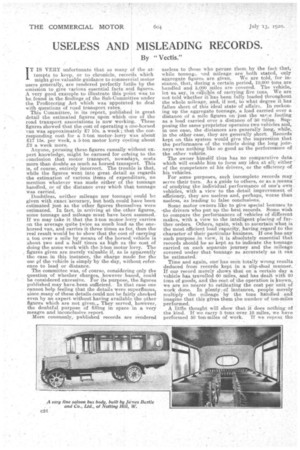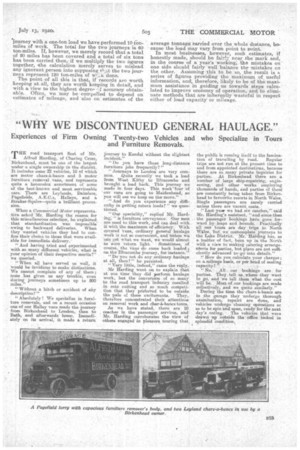USELESS AND MISLEADING RECORDS.
Page 22

Page 23

If you've noticed an error in this article please click here to report it so we can fix it.
By " Vectis."
IT IS VERY unfortunate that. so many of the attempts to keep, or to chronicle, records which might give valuable guidance to commercial motor users generally, are rendered perfectly futile by the omission to give various essential facts and figures. A very good example to illustrate this point was to be, found in the findings of the Sub-Committee under the Profiteering Act which was appointed to deal with questions of road transport rates.
This Committee, in its. report, published in great detail the estimated figures upon which one of the road transport associations is now working. These figures showed that the cost of operating a one-horsed van was approximately £7 10s. a week; that the, corresponding cost for a 3-ton motor, lorry was about £17 las. per week, a 5-ton motor lorry costing about £2 a week more.
Anyone, perusing these figures casually without expert knowledge, might be excused for cofning to the conclusion that motor transport, nowadays, costs more than double as much as horsed transport. This is, of course, entirely incorrect. The trouble is that, while the figures went into great detail as regards the estimation of various items of expenditure, no mention whatever was made either of the tonnage handled, or of the distance over which that tonnage was carried.
Doubtless, neither mileage nor tonnage could be given with exact 'accuracy, but both could have been estimated just as the other figures themselves were estimated. In fact, in arriving at the other figures, some tonnage and mileage must have been assumed. If we may take it that the 3-ton motor. lorry carries on the average quite twine as much load as the onehorsed van, and carries it three times as far, then the real result would be to show that the cost of carrying a ton over a mile by means of the horsed vehicle is about two and a half times as high as the cost of doing the same work with the 3-ton motor lorry. The , figures given are merely valuable if, as is apparently the case in this instance, the charge made for the use pf the vehicle is simply by the day, without reference to load or distanee.
The committee was, of course, considering only the question of whether charges, however based, could be considered excessive. For its purpose, the figures published may have.been sufficient. In that case one cannot help feeling that the details were superfluous., since many of these details could not be fairly checked even by an expert without having available the other figures which are not given.. They served, however, the doubtful purpose of filling in space in a very
meagre and inconclusive report . More commonly, pablished records a-re rendered useless to those who peruse them by the fact that, while tonnag, and mileage are both stated, only aggregate figures are given. We are told, for instance, that, during a certain period, 10,000 tons are handled and 5,000 miles are covered. The vehicle, let us say, is caNble of carrying five tons. We are
not told whether it been fully loaded throughout the whole mileage, and, if not, to what degree it has fallen short of this ideal state of affairs. In reckoning up the aggregate tonnage, a load carried over a distance of a mile figures on •just the sar,e footing as a load carried over a distance of -50 miles. Supposing the same 'proprietor operates two vehicles and, in one ease, the distances are generally long, while, in the other case, they are generally short. Records kept on this system would give the impression that the performance -of the vehicle &frig the long iotirneys was nothing like so good as the performance of the other vehicle.
The owner himself thus has no comparative data which will enable him to form any idea. it all; either of the competence of his drivers, or the efficiency of his vehicles.
For some purposes, such incomplete records may. serve their turn. As a guide to others, or as a means of studying the individual performance of one's own vehicles, with a view to the detail improvement of efficiency, they are useless and, -perhaps, worse than useless, as leading to false conclusions.
Some motor owners like to give special bonuses to -the drivers who put up the best records. Some wish to compare the performances of vehicles of different makes, with a view to the intelligent placing of further ordea-s. Others, again, wish to ascertain. what is the most efficient load capacity, having regard to the character of their particular business. If one has any such purpose in view, it is absolutely essential that records should be so kept as to indicate the tonnage carried on each separate journey and the mileage covered under that tonnage as accurately as it can be estimated..
Time and again, one' has seen .totally wrong results deduced from records kept in a Slip-shod manner. If our record merely shows that on a. certain day a vehicle has travelled 60 miles, and has dealt with 20 tons of goods, and the cost of the operation is known, we are no nearer to estimating the -cost per -unit of work done. In plenty of instances, people merely multiply the mileage by the tons handled and imagine that this gives them the number of ton-miles performed.
A little thought will show that it does nothing of the kind, If we carry 5 tons over 10 miles, we have performed 50 ton-miles of work. If we repeat the journey with a one-ton load we have performed 10 Ion-. miles of work. The total for the two journeys is 60 ton-miles. If, however, we merely record that a total of 20 miles has been covered and a total of six tons has been carried then,if we multiply the two ugures together, -the calculation merely serves to mislead any ignorant person into supposingti-it the two journeys represent 120 ton-miles of w1( done. The point of all this is that, if records are worth keeping at all, they are worth koping in. detail., and with a, view to the highest degree f aceuraoy obtainable. Often, we may be • compelled to depend on estimates of mileage, and also on estimates of the average tonnage Carried over the whole distance, be cause the load may vary from point to .point. •
In most businesses, however, such estimates, if honestly made, should be fairly near the mark and, in the course of a year's working; the mistakes on one side should fairly well -balance the -mistakes on the other. Assuming this to be so, the result is a series of figures providing the maximum of useful information, and, therefore, likely to be of the maximum assistance in guiding us towards steps calculated to improve economy of operation, and to eliminate methods that are inherently wasteful in respect either of load capacity or mileage.




























